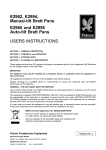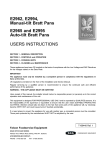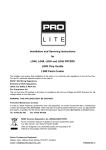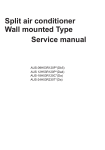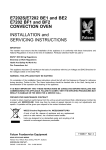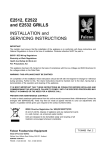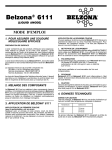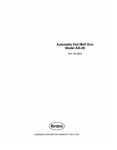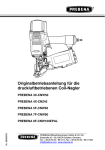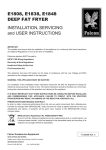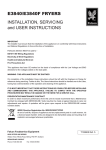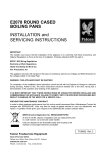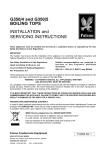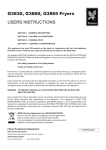Download Chieftain Electric Bratt Pans Installation & Service Instructions
Transcript
E2962, E2994, Manual-tilt Bratt Pans E2965 and E2995 Auto-tilt Bratt Pans INSTALLATION and SERVICING INSTRUCTIONS IMPORTANT The installer must ensure that the installation of the appliance is in conformity with these instructions and National Regulations in force at the time of installation. Particular attention MUST be paid to - BS7671 IEE Wiring Regulations Electricity at Work Regulations Health And Safety At Work Act Fire Precautions Act This appliance has been CE-marked on the basis of compliance with the Low Voltage and EMC Directives for the voltages stated on the Data Plate WARNING -THIS APPLIANCE MUST BE EARTHED On completion of the installation these instructions should be left with the Engineer-in-Charge for reference during servicing. Further to this, The Users Instructions should be handed over to the User, having had a demonstration of the operation and cleaning of the appliance. IT IS MOST IMPORTANT THAT THESE INSTRUCTIONS BE CONSULTED BEFORE INSTALLING AND COMMISSIONING THIS APPLIANCE. FAILURE TO COMPLY WITH THE SPECIFIED PROCEDURES MAY RESULT IN DAMAGE OR THE NEED FOR A SERVICE CALL. PREVENTATIVE MAINTENANCE CONTRACT In order to obtain maximum performance from this unit we would recommend that a Maintenance Contract be arranged with SERVICELINE. Visits may then be made at agreed intervals to carry out adjustments and repairs. A quotation will be given upon request to the contact numbers below. WEEE Directive Registration No. WEE/DC0059TT/PRO At end of unit life, dispose of appliance and any replacement parts in a safe manner, via a licenced waste handler. Units are designed to be dismantled easily and recycling of all material is encouraged whenever practicable. Falcon Foodservice Equipment HEAD OFFICE AND WORKS Wallace View, Hillfoots Road, Stirling. FK9 5PY. Scotland SERVICELINE CONTACT PHONE - 01438 363 000 FAX - 01438 369 900 T100448 Ref. 2 Warranty Policy Shortlist Warranty does not cover :Correcting faults caused by incorrect installation of a product. Where an engineer cannot gain access to a site or a product. Repeat commission visits. Replacement of any parts where damage has been caused by misuse. Engineer waiting time will be chargeable. Routine maintenance and cleaning. Gas conversions i.e. Natural to Propane gas. Descaling of water products and cleaning of water sensors where softeners/conditioners are not fitted, or are fitted and not maintained. Blocked drains. Independent steam generation systems. Gas, water and electrical supply external to unit. Light bulbs. Re-installing vacuum in kettle jackets. Replacement of grill burner ceramics when damage has been clearly caused by misuse. Where an engineer finds no fault with a product that has been reported faulty. Re-setting or adjustment of thermostats when unit is operating to specification. Cleaning and unblocking of fryer filter systems due to customer misuse. Lubrication and adjustment of door catches. Cleaning and Maintenance Cleaning of burner jets Poor combustion caused by lack of cleaning Lubrication of moving parts Lubrication of gas cocks Cleaning/adjustment of pilots Correction of gas pressure to appliance. Renewing of electric cable ends. Replacement of fuses Corrosion caused by use of chemical cleaners. SECTION 1 - INSTALLATION UNLESS OTHERWISE STATED, PARTS WHICH HAVE BEEN PROTECTED BY THE MANUFACTURER ARE NOT TO BE ADJUSTED BY THE INSTALLER 1.1 MODEL NUMBER, NETT WEIGHTS and DIMENSIONS 1.4 LOADING The electrical loadings are stated on the data plate. WIDTH DEPTH HEIGHT WEIGHT WEIGHT mm mm mm kg lbs MODEL E2962 600 770 870 123 270 E2994 900 770 870 165 364 E2965 600 770 870 123 270 E2995 900 770 870 165 364 The appliance must be installed on a firm, level floor in a well lit position. If levelling is necessary this is effected by adjusting the feet. 1.3 WIRING These models are suitable for use on AC supply, i.e. single phase or 3 phase systems. It is important to ensure that the terminals are correctly arranged to suit supply available. The main terminals are situated behind wiring guard, inside bottom door. The cable entry is located at the rear of unit. The connection to main electric supply must be made through a suitable isolating switch with a contact separation of at least 3mm in all poles. Wiring should conform to I.E.E. regulations and the installation should satisfy local supply authority. Note When connecting unit to a single phase supply, the three line terminals must be joined using phase link provided. It is important that these connections are made exactly as shown in the following diagram. N L1 L2 L3 Supply Cables N L1 Warning THIS APPLIANCE MUST BE EARTHED. A terminal for this purpose is provided adjacent to supply terminals. An equipotential terminal is also provided at rear of unit. Note The various components and their functions are as follows:- Contactor Switches current to elements on and off when controlled by thermostat. Microswitch This produces a closed circuit when pan is level. Microswitch 1.2 SITING Figure 1 1.5 CONTROLS Precautions regarding earth leakage must be taken during installation. This prevents automatic tilting with bottom door open. Red Indicator Lamp This neon indicates that mains electricity is ON. Amber Indicator Lamp This neon indicates when current is supplied for elements to heat pan. User's Thermostat (with knob) This controls temperature of pan contents. Safety Thermostat This controls thermostat in the event of working thermostat failure. Change-over Switch (E2965/95 only) This controls change function from heat to tilt. Important After installation, the engineer should check that all electrical connections are secure. The engineer should check that appliance is functioning correctly before leaving the kitchen. They should also demonstrate the operating procedure to staff and point out the location of isolating switch for use in an emergency or during cleaning. SECTION 2 - SERVICING Important Safety Notes 1. Before attempting any servicing, isolate appliance at main switch. Take steps to ensure that it is not inadvertently switched on. 2. Certain operations require pan to be tilted or repositioning of actuator with control panel removed. If this is done electrically, care should be taken not to touch live terminals. The control panel requires to be supported so that none of the live switch or thermostat terminals can come into contact with earthed parts. 2.1 CONTROL PANELS - To Remove 2.1.1 Main Panel Ensure pan is in DOWN position. Open bottom front drop-down door. Pull off thermostat knob. Remove fixings at corners of control panel bottom edge and those at top flange. Pull panel clear of unit and rest it carefully on floor. Take care not to strain wiring to change-over switch. Replace in reverse order. 2.1.2 Inner Panel Remove fixings from either side and pull clear. 2.2 REMOVAL OF ELEMENTS Tilt pan to fully raised position to allow access to element compartment. Remove element terminal by undoing fixings and pull back. Pull off wires attached to elements, noting respective positions for replacement. Undo fixing which retains earth wire and remove cover completely. Undo nuts which secure element cover and insulation. Element cover should now drop away from pan. Each element is held down by eight clamps, each secured by a nut. Undo nuts and clamps to remove elements. To replace, assemble in reverse order. 2.3 TILT SWITCH MECHANISM (E2965/95 only) To Remove a) Remove control panel as detailed in Section 2.1. b) Raise pan (Refer to Safety Note 2). c) Undo locknut at bottom of the main rod. Unscrew and remove rod. d) Undo electrical connections. e) Remove fixings which secure mechanism to base angle. Remove mechanism. To Replace Replace in reverse order with main rod and adjusting screws both screwed fully home. This will prevent damage to switch when pan is lowered, prior to setting. To Set There are two ways to set switch a) For coarse setting, use main rod. b) For fine setting, use screw which presses on microswitch lever. The switch should be set with pan in fully lowered position. Adjust until switch closes. 2.4 NEONS These are not repairable. To replace a neon, first remove control panel. Remove connections and depress shoulder clips to remove from panel. Fit replacement neon, shoulder clips will retain it in position. Finally replace electrical connections. 2.5 THERMOSTAT To Remove a) Remove control panel as detailed in Section 2.1. b) Raise pan fully (Refer to Safety Note 2). c) Remove phial clamp plates fixings from pan underside. d) Pull off connections, noting locations. e) Remove fixings which secures thermostat to bracket. f) Remove thermostat and thread capillary tube and phial through apertures. g) Replace in reverse order. 2.6 HIGH TEMPERATURE LIMIT DEVICE Set to trip at 232oC, device should not be interfered with unless cut-out has occurred and re-setting is required. To Reset a) Remove control panel as detailed in Section 2.1. b) Press down pin on top of thermostat. c) Replace control panel. To Replace To replace, follow instructions for thermostat. 2.7 CONTACTOR - Removal a) Open control compartment door. Remove the controls cover by undoing the fixing at either end. b) Disconnect the wires from the contactor, noting their respective positions for correct replacement. Note When replacing a contactor, wires can be transferred to replacement to respective positions while disconnecting from existing component. c) Remove fixings (2) which secure contactor to mounting panel. d) To replace, assemble in reverse order. 2.8 CHANGE-OVER SWITCH (E2965/95 only) To Remove a) Remove control panel as detailed in Section 2.1. b) Remove electrical connections. c) Remove knob and undo fixings (for E.G.O. switches) or nut (for Arrow switch). d) Replace in reverse order. 2.9 AIR SWITCHES (E2965/95 only) To Remove a) Remove control panels as detailed in Section 2.1. b) Undo electrical and air connections. c) Remove fixings which secure switch bracket to base plate. d) Remove fixings from base of bracket. It is important that a replacement switch be fitted with identical fixings. Longer or larger diameter screws may damage switch. Care should be taken to retain these fixings. e) Replace in reverse order. Pay attention to note (d) above. 2.10 DOOR SWITCH (E2965/95 only) To Remove a) Remove both panels. b) Disconnect electrics. c) Undo the fixings. d) Replace in reverse order. 2.11 LINEAR POWER PACK (E2965/95 only) To Remove a) Remove both panels. b) Raise pan to approximately half-way and support. c) Remove the top fulcrum pin. d) Lower the actuator completely. e) Disconnect the electrical connection. f) Undo fixings which secure handle guide tube. Twist tube anti-clockwise and remove. Tighten screws. g) Remove bottom fulcrum pin. h) Ease actuator out. j) Loosen grub screw and remove spindle adaptor. k) Replace in reverse order. 2.12 FOOT PADS (E2965/95 only) To Remove a) Remove main panel. b) Undo air pipes from air switch. c) Turn pad (anti-clockwise DOWN pad/clockwise UP pad) approx. 20o until free of the retaining ring. d) Pull tube through hinge tube and conduit. e) If necessary, remove retaining ring from platform by removing fixings. f) Replace in reverse order, take care not to check the tubing. General Note After any maintenance task, check appliance to ensure that it performs correctly. Carry out any adjustments necessary as detailed in Section 1 Installation. Spare Parts When ordering spare parts, always quote appliance type and serial number. This information will be found on data badge attached to controls cover behind control compartment door. The appliance should never be cleaned by hosing down with a jet of water or steam cleaned. Service Contact Service Line number on the front of this manual. MARGAID GNIRIW - NAP TTARB 2692E MARGAID GNIRIW - NAP TTARB 4992E MARGAID GNIRIW - NAP TTARB 5692E MARGAID GNIRIW - NAP TTARB 5992E









